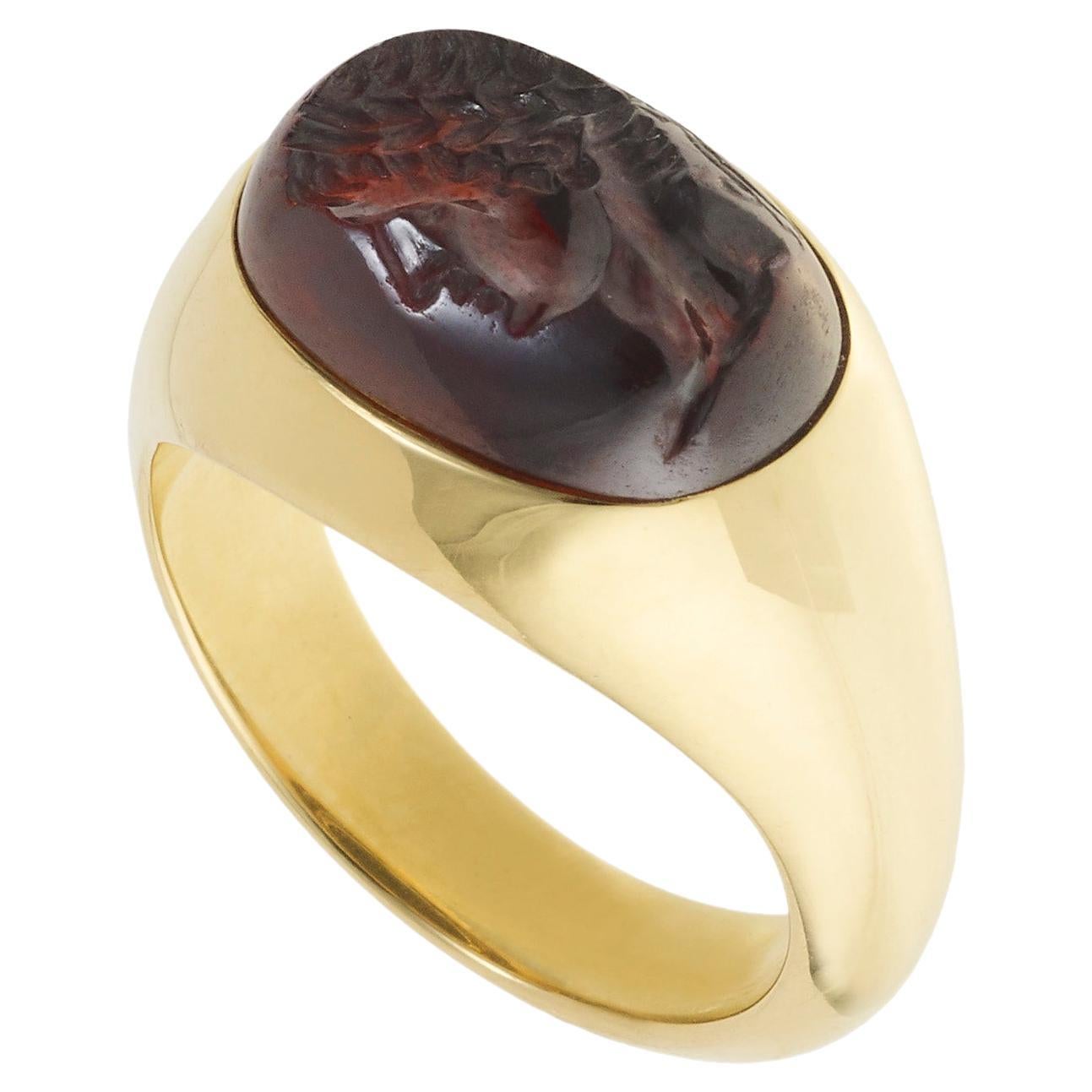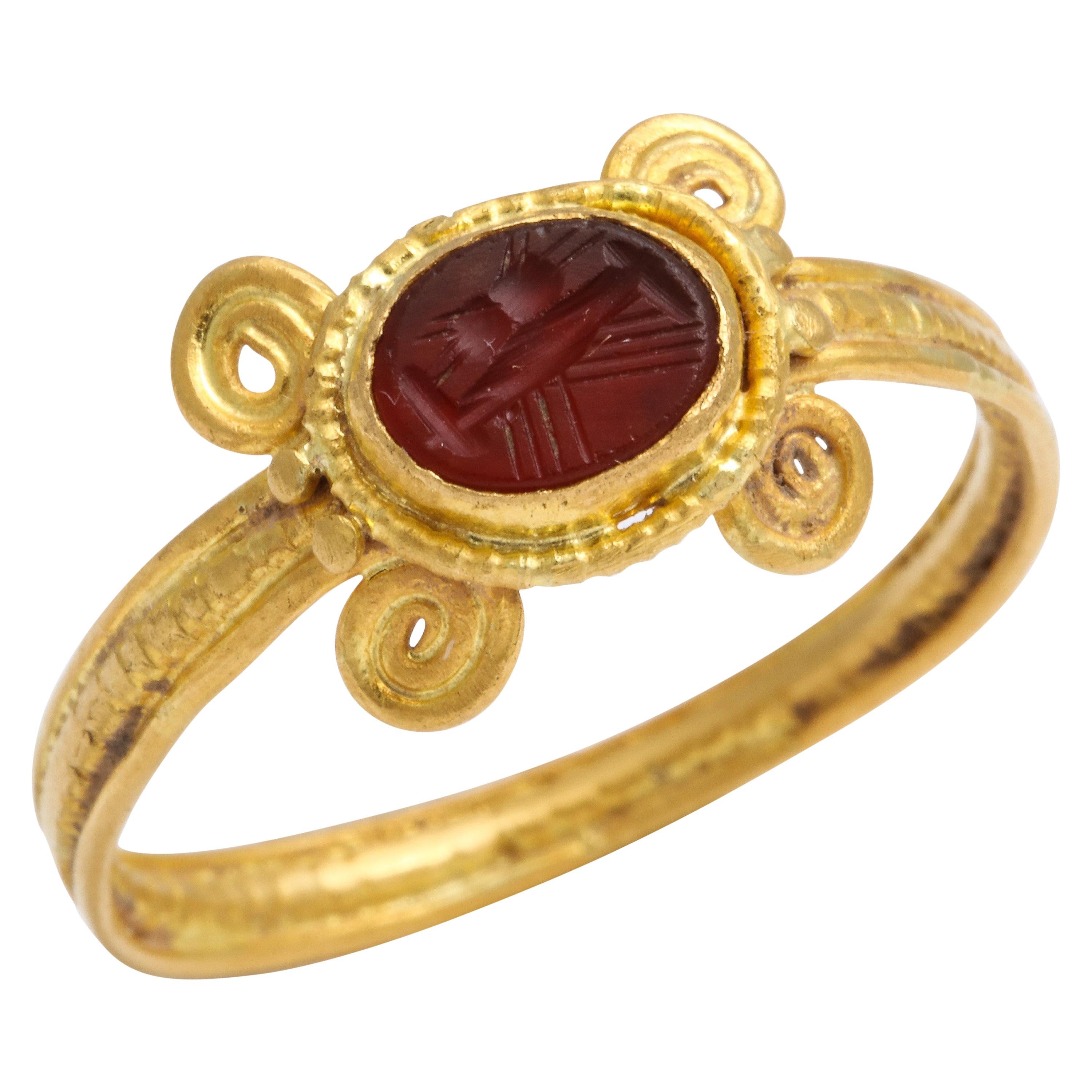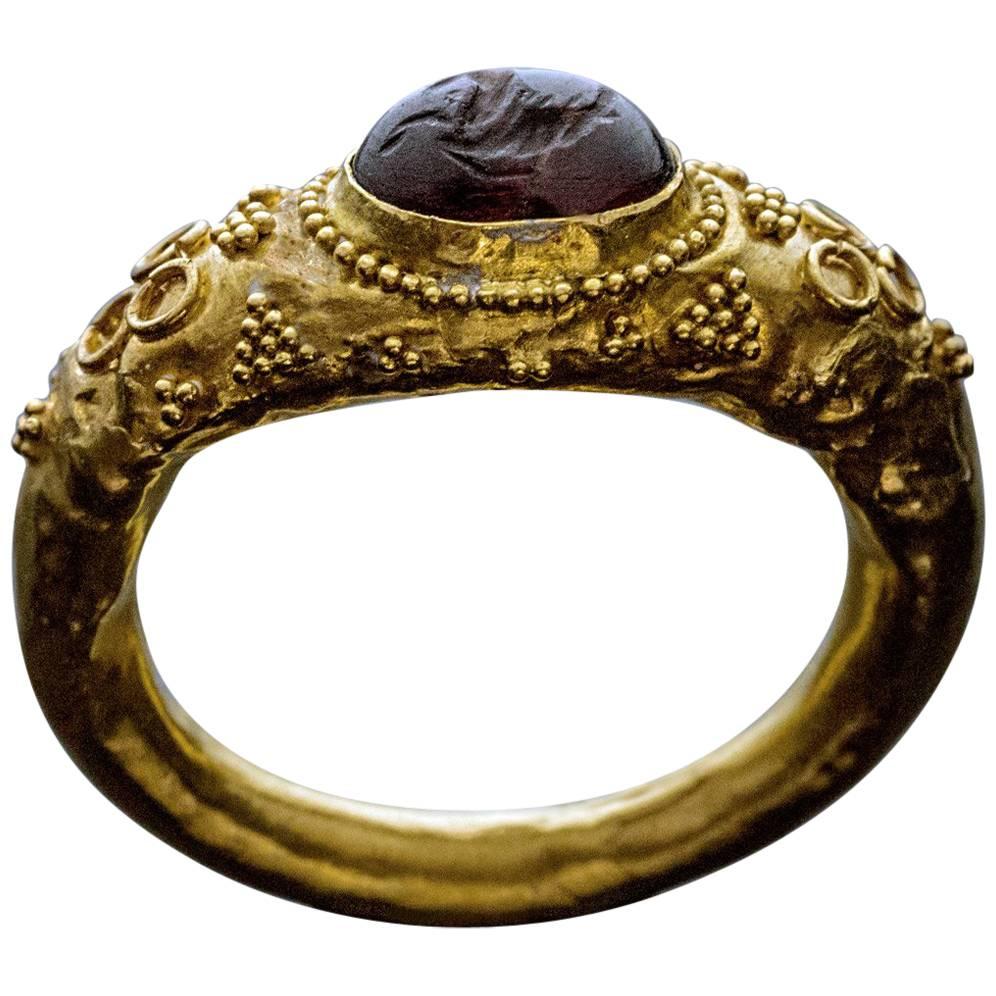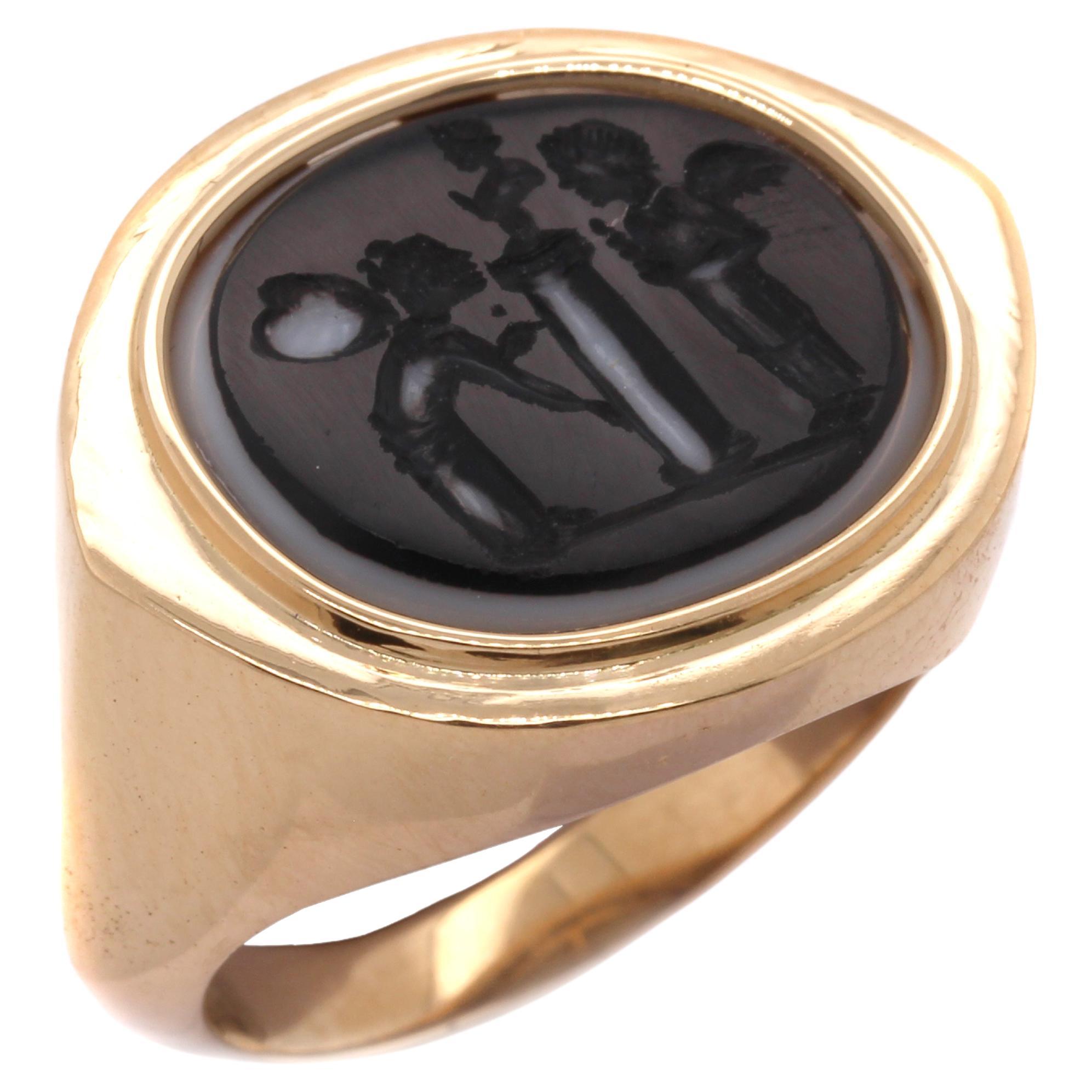Items Similar to Ancient Roman Green Chalcedony Plasma Intaglio Ring of Goddess Victoria Nike
Want more images or videos?
Request additional images or videos from the seller
1 of 14
Ancient Roman Green Chalcedony Plasma Intaglio Ring of Goddess Victoria Nike
About the Item
A scarce ancient Roman intaglio dating from the 1st to 2nd century AD, depicting Victoria, the Roman Goddess of Victory (also known as Nike in Greek mythology). The cabochon gemstone is a chromium chalcedony, mottled green in colour. It was known in the ancient world as a ‘plasma’ stone and was widely used in jewellery and seals throughout the Roman Empire. However the mineral disappeared from use in the ancient world towards the end of the 2nd century AD when the known deposits were mined out.
The intricate ancient engraving depicts a winged Victoria, draped and facing left, holding a palm branch in her right hand and a laurel leaf in her left. The green gem is translucent and contains small dotted black natural inclusions. The gemstone’s viridian green tones were linked to nature, growth, and prosperity, reflecting the Romans' appreciation for abundance and fertility.
Victoria played a major part of Roman society, with many temples erected in her honour including one on the Palatine Hill which would house the spoils of war from Roman victories. She was, to the Romans, a symbol of victory over death, ultimately determining who would be successful during war. The high number of artistic and architectural dedications to her bear witness to the popularity of the goddess’ cult: Victoria widely appears on Roman coins, jewellery, architecture, and other works of art.
The ancient intaglio is set in a later high-karat gold mount, probably dating from the 18th or early 19th centuries but crafted in keeping with ancient ring types. The bezel features a fine beaded rim, which leads to chased and arrowed shoulders. While undoubtedly being a status symbol in Roman society, wearing these gems served a more serious purpose as well; they were thought to to have apotropaic or prophylactic properties. Various similar examples of intaglios reside in notable collections and museums. See the British Museum (1923,0401.208, 1872,0604.175, 1987,0212.219, 1987,0212.221) and the Metropolitan Museum (81.6.100). Message for photos of these examples.
UK size J 1/2, US size 5
The ring weighs 6 grams and the intaglio measures 10mm x 9mm. The solid gold ring is unmarked but tests as high karat gold (21K).
The art of engraving gemstones has been admired since the early days of the Roman empire. However it was revived in Europe during the Renaissance, and again in the 18th and 19th centuries. Cameos and intaglios were prized and collected, sometimes as symbols of power and mounted in jewelled settings, sometimes as small objects for private devotion or enjoyment.
- Ring Size:5 US, Not Resizable
- Metal:
- Stone:
- Stone Cut:
- Weight:6 g
- Style:
- Place of Origin:
- Period:
- Date of Manufacture:200
- Condition:Wear consistent with age and use.
- Seller Location:London, GB
- Reference Number:1stDibs: LU2845222110112
About the Seller
5.0
Vetted Seller
These experienced sellers undergo a comprehensive evaluation by our team of in-house experts.
Established in 2019
1stDibs seller since 2022
32 sales on 1stDibs
Typical response time: 11 hours
- ShippingRetrieving quote...Ships From: London, United Kingdom
- Return PolicyA return for this item may be initiated within 14 days of delivery.
More From This SellerView All
- Georgian 18th Century Signet Ring with Ancient Roman Nicolo Intaglio of HerculesLocated in London, GBA superb ancient Roman nicolo intaglio set in a late 18th century gold signet ring. Nicolo intaglios are a particular type of intaglio ma...Category
Antique Late 18th Century English Georgian Signet Rings
- Ancient Roman Carved Red Jasper Gryllus Signet Ring Antique GeorgianLocated in London, GBAn ancient Romano-British carved jasper intaglio dating from the 2nd to 3rd century AD, set in a later gold mount dating from the late 18th century. The intaglio is intricately carve...Category
Antique 15th Century and Earlier Italian Georgian Signet Rings
MaterialsJasper
- Museum-Grade Antique Early Seljuk ‘Selçuklu’ Period Islamic Intaglio RingLocated in London, GBThis incredible gold ring dates from the 12th century Seljuk dynasty. The carnelian intaglio is set within a typical Seljuk tapered rectangular bezel with a four-pronged gold setting...Category
Antique 15th Century and Earlier Asian Signet Rings
MaterialsCarnelian, 22k Gold
- French Neo-Renaissance Intaglio Signet Ring Manner of Wièse & Froment-MeuriceLocated in London, GBA fantastic French 19th century Neorenaissance silver intaglio ring, in the manner of Jules Wièse and Froment-Meurice, circa 1840. The milky blue ...Category
Antique Mid-19th Century French Belle Époque Signet Rings
MaterialsChalcedony, Silver
- Important Antique Finnish 18K Coat of Arms Klinckowström Intaglio Signet RingLocated in London, GBA superb, scarce Finnish antique 18K gold ring that was made in Helsinki in the year 1854. The oval carnelian coat of arms intaglio is set in a large intricate gold repoussé work mount featuring scrolled foliate motifs. Incredibly, thanks to a full set of Finnish hallmarks, as well as from the intaglio carving itself, we can identify who commissioned and wore this superb seal ring. The coat of arms engraved into the carnelian gemstone is that of the Klinckowström family, an old Prussian noble house whose members played prominent roles in the history of Prussia, Sweden, Finland and Austria. The family was granted nobility in Sweden in 1684 by King Charles XI, and then received the rank of baron in 1759 from King Adolf Frederick. The baronial branch was listed in the Finnish House of Nobility (Ritarihuone) from 1818 until the family line ended in Finland in 1883. This baronial element can also be seen in the engraved coat of arms from the specific type of coronet used, it is set with pearls and known as a ‘Friherrlig rangkrona’, the coronet for Baron. The hallmarks tell us that this ring was made in Helsinki in the year 1854. Accordingly, the ring must have been made for a Baron (male) of the Klinckowström family, present and active in Finland during the mid-19th century. After researching into the genealogial records, only one member of the family settled in Finland, which was Baron Otto Wilhelm Klinkowström (1778-1850), and this ring would have been commissioned by his son Baron Arthur Wilhelm Wilhelmsson Klinckowström, shortly after his father’s passing. The ring would have been made in used to seal deeds and important letters in wax regarding family affairs. Arthur had two sons. Emil and Alexander who carried on the baronial title until 1883, when the family line ended on the male side. Although the time period of this ring also matches up with his both his sons, according to heraldry records they both carried a slightly different coat of arms. Arthur, the owner of this ring enrolled in the House of Knights in Finland aged 17 and soon after received the Order of St. John of Jerusalem. He spent the remainder of his years in various senior military positions, such as Lieutenant Colonel of the Finnish Sharpshooter Battalion and Colonel of the Kremenchugska Hunter Regiment. He passed away in 1860, not long after his father, which may explain why this ring is in such excellent condition with minimal signs of usage. His father, Baron Otto Wilhelm Klinkowström (1778-1850) was a Swedish lieutenant general who later moved to Finland, where he immediately found favour with Czar Alexander I of Russia...Category
Antique 1850s Finnish Victorian Signet Rings
Materials18k Gold
- Rare Ancient Egyptian Carved Carnelian Frog Amulet Swivel Ring 18th DynastyLocated in London, GBThis rare Egyptian carved carnelian frog amulet dates to the Eighteenth Dynasty of the New Kingdom, circa 1300 BC. Frog amulets, depicting the goddess Heket, were commonly worn by both the living as a fertility charm and the dead to provide rejuvenation and a long afterlife. The ancient amulet is pierced horizontally and set into a later gold swivel mount, probably dating from the late 19th century. The design of the gold mount inspired by rings worn by the ancient Egyptians and Etruscans with its swivel bezel and coiled wire on the shoulders. The immense number of offspring made the frog an important symbol of fertility in ancient Egypt, and carved frog amulets were worn by women hoping for an easy delivery. This is exemplified with the goddess and protector of birth, Keket, who was depicted as a frog. After death, frog amulets would be placed within the wrappings of mummies, both men and women, in hope of a successful rebirth in the afterlife. The association between this amphibian and rebirth may have been induced by the fact that every year, millions of frogs spontaneously appeared out of the river mud and filled the fields after the annual inundation of the Nile. This caused the Egyptians to believe that they spontaneously generated themselves out of the river mud. The influence of frogs in Ancient Egypt can be seen in the language, the hieroglyphic sign for "one hundred thousand" was a tadpole, and one of the Egyptian terms denoting "frogs" is whm-anx, meaning literally "they who repeat life." Similar examples of ancient Egyptian carved...Category
Antique 15th Century and Earlier Signet Rings
MaterialsCarnelian, 22k Gold
You May Also Like
- Gold And Ancient Roman Imperial Intaglio of Roman Goddess Salus RingLocated in Firenze, ITOval bezel set with a orange coloured agate intaglio (13.7 x 11.6 mm) carved with a profile of Roman goddess Salus. Bezel 1.5 x 1.3 cm. Ring size 59. Weight 4.43 g. Salus (Latin: sa...Category
Antique 15th Century and Earlier Italian Classical Roman Signet Rings
MaterialsAgate, Gold
- Victoria Strigini: Ancient Roman Garnet Intaglio in 18k Gold Chevalière RingLocated in New York, NYVictoria Strigini (b. 1991) A contemporary 18k yellow gold ring, featuring a 2nd- 3rd century AD Roman cabochon intaglio in garnet, set in a strikingly pure, rounded modern mount. A...Category
Antique 15th Century and Earlier English Classical Roman Signet Rings
MaterialsGarnet, 18k Gold
- Ancient Roman Amethyst Intaglio Gold RingLocated in Chicago, ILRoman, circa 2nd – 1st centuries BC A museum quality, finely modeled, high carat (approximately 22.5K), hollow gold signet ring is set with an oval amethyst intaglio...Category
Antique 15th Century and Earlier Signet Rings
MaterialsAmethyst, Gold
- Ancient Roman Carnelian Intaglio Ring with Clasped HandsLocated in Stamford, CTWe are proud to show this circular hoop of 22 Kt gold, with coiling around the shoulders, sets an oval shaped intaglio"dextrarum lunctio" on the carnelian. This translates to clasped...Category
Antique 15th Century and Earlier Italian Classical Roman Band Rings
MaterialsCarnelian, 22k Gold
- Ancient Roman Garnet Intaglio Gold RingLocated in Chicago, ILA museum quality ancient Roman gold ring, circa 400 AD. This hollow ring is bezel-set with a garnet intaglio of Hippocamp – a fish-tailed horse that w...Category
Antique 15th Century and Earlier Signet Rings
- Castellani Ancient Roman Agate Intaglio Gold RingBy CastellaniLocated in New York, NYCastellani® has selected this Ancient Roman Agate Intaglio for the "Cleopatra" Ring Setting. The intaglio dates to the 3rd to 7th Century. The intaglio is both black and white agate, which is a hard stone and very good for carving. The agate has two layers of color, black on the top and white at the bottom. The agate intaglio is solid and is one piece. The carver was able to use these two color layers to give dimension and detail. The Column and Angel on the left wings are white and the balance is all black. The Carver knew the material he/she was carving and used this to create this very unique scene. The intaglio shows two angels standing on either side of a column/pillar looking at the bust of a man on top of the pillar. The angels are female and male. The bust on the pedestal is of a male. The intaglio is set below the frame. The frame flairs out to a subtle point on the sides and has a flat surface. The "Cleopatra" ring design was a style that Castellani created in the 1860's and was inspired by Ancient Roman rings...Category
21st Century and Contemporary American Etruscan Revival Signet Rings
MaterialsAgate, 18k Gold, Gold





